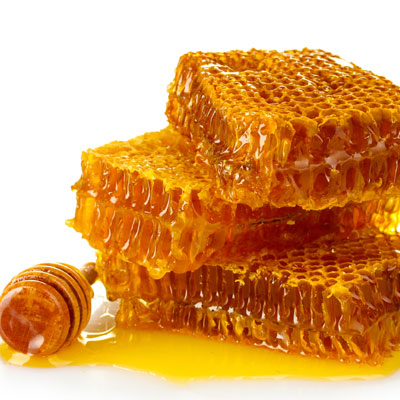 What it is: Honey is a sweet, sticky yellow-brown liquid, made by bees from the nectar they collect from flowers. Honeybees make honey by a process of regurgitation and evaporation, storing it in wax honeycombs inside a beehive.
What it is: Honey is a sweet, sticky yellow-brown liquid, made by bees from the nectar they collect from flowers. Honeybees make honey by a process of regurgitation and evaporation, storing it in wax honeycombs inside a beehive.
Where it’s from:
Honeybees originated about 130 million years ago. Honey dates back to 2 100B.C. – it was mentioned in old Sumerian and Babylonian writings, the sacred writings of India and Egypt and many others. It is presumed that honey is even older than that!
Where it’s produced:
Although humans have been colleting honey from wild bees for thousands of years, efforts to domesticate them are shown in Egyptian art around 4 500 years ago. Beekeeping (apiculture) involves maintaining honeybee colonies in hives. Today, China, Turkey and the Ukraine are the top producers of natural honey, while significant regional producers include the United States and Russia.
What it tastes and looks like:
The flavour of honey depends on the nectar gathered by bees from various flower sources. They can range from mild to aromatic or spicy and are often combined to create the perfect balance. Colours range from near white to yellow, yellow-green, gold, amber, dark brown or even red and nearly black.
How to eat / use it:
Honey comes in a variety of forms, such as liquid, comb, cut-comb, solid (granulated or crystallised) and chunk. You can use honey as a sweetener in your tea, substitute honey for sugar in your recipes or drizzle it over your muesli for breakfast. Honey is also primarily used in baking goods because of its ability to absorb and retain moisture.
A good source of:
Similar to the synthetically produced inverted sugar syrup, honey mainly consists of fructose and glucose. With trace amounts of vitamins and minerals, honey also includes maltose, sucrose and water.
Benefits:
A commonly known benefit of honey is its ability to reduce cough and throat irritation. It has been found to be just as effective as dextromethorphan – an active ingredient in many cough and cold medicines. Current scientific research suggests that honey may help disorders such as ulcers and bacterial gastroenteritis, and may help reduce the risk of some cancers and heart disease. Honey has also been shown to have antiseptic, antibacterial and antifungal qualities.
Yoghurt drizzled with Honey and Walnuts
Delight your taste buds with this mouth-watering recipe courtesy of marthastewart.com.
Ingredients
• About ¾ cup walnut halves
• 1 cup good-quality honey (such as clover or wildflower)
• 680g plain low-fat yoghurt (try using low-fat Greek-style yoghurt as its thicker and richer in flavour)
Method
Step 1: Preheat the oven to 180°C. Spread the walnuts in a single layer on a rimmed baking sheet, and toast until fragrant and golden brown – about 7 to 8 minutes. Transfer to plate. Rub with a damp kitchen towel to remove as much loose skin as possible.
Step 2: While still warm, place walnuts in a small bowl, pour honey on top and stir to coat evenly. Let cool for about 2 minutes.
Step 3: Divide yoghurt among six dessert bowls, and spoon honey mixture over each. Serve immediately.
Other articles you may be interested in:
Food of the month: Coconut oil
Food of the month: Oats
Different types of sweetener
Going batty for Brazil nuts
Healthy party snacks





22 Responses
I love honey, especially on my oats! It is a much better choice than syrup!
Guilt free sweetness!
I don’t use sugar in anything so honey has been my go-to for almost a year now and I love it. You also learn to slow down with adding something to sweeten a drink/meal over time.
Love honey and yoghurt with seeds in it! Delish!
Never experiments with honey, might try a few things other than eating it.
I wonder who thought to take the honey from the hive and eat it? I love honey and I use it as a substitute for sugar is pretty much everything. At first the taste was a bit weird but I got used to it, and it makes a great face mask when applied with cinnamon.
Awesome, there is a honey cough mixture that our family drinks when we are sick and it works like a bomb, teamed with honey and ginger tea you are good to go. But there are a lot of beauty products that also use honey.
Yum yum yum!!! I drink hot water with honey and lemon every morning!
I love Honey in tea, it’s delicious and such a useful product. I always use it in salad dressing with fat free plain yogurt, fresh grated garlic and dried basil. Delicious over baby spinach salad.
Honey is indeed a great product to have in your home.